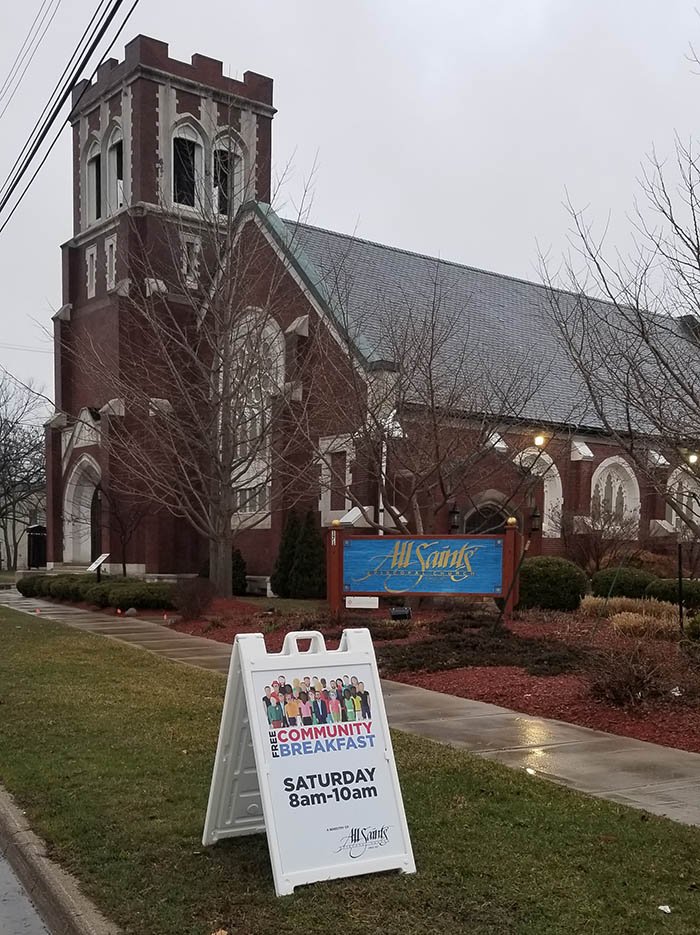March was a hectic month for All Saints’ Episcopal Church in Pontiac, a city 30 miles outside of Detroit. News of a global pandemic and rapidly changing guidelines for containing its spread forced the congregation to make quick decisions on the suspension or adaptation of its programs and activities, many of which were housed in its large, historic building. The congregation had been providing free community breakfasts and hosting an affordable farmer’s market every weekend. A youth services organization ran out of their basement, and the church’s classrooms and offices were used every day for various community and congregational activities. The Rev. Chris Johnson, the parish’s rector, along with his leadership team, knew that complying with shelter-in-place recommendations was crucial to public health efforts. However, they also knew that the need for All Saints’ community presence and participation would increase. How best could All Saints’ use its abundant resources in this unprecedented time?
In just a few short weeks, the novel Coronavirus, and efforts to cope with its impact, effectively shut down America’s houses of worship. As states across the U.S. implemented shelter-in-place orders, clergy and lay leaders scrambled to move activities to virtual platforms, develop new protocols for congregational care, and find ways to contribute to relief efforts while maintaining social-distance. The sudden loss of churches, temples, mosques, and synagogues as gathering spaces has thrown into sharp relief the vital role they play in congregational and community life. Sacred spaces are essential service sites, providing space for homelessness relief, feeding programs, recovery meetings, child care and education, and a myriad of other services. The programs and services hosted by faith communities have had to adapt quickly, without a guide or model to follow. Congregations are learning not only about their limitations during such unprecedented times, but also their potential; many have been surprised most by what they still can do, rather than what they can’t.
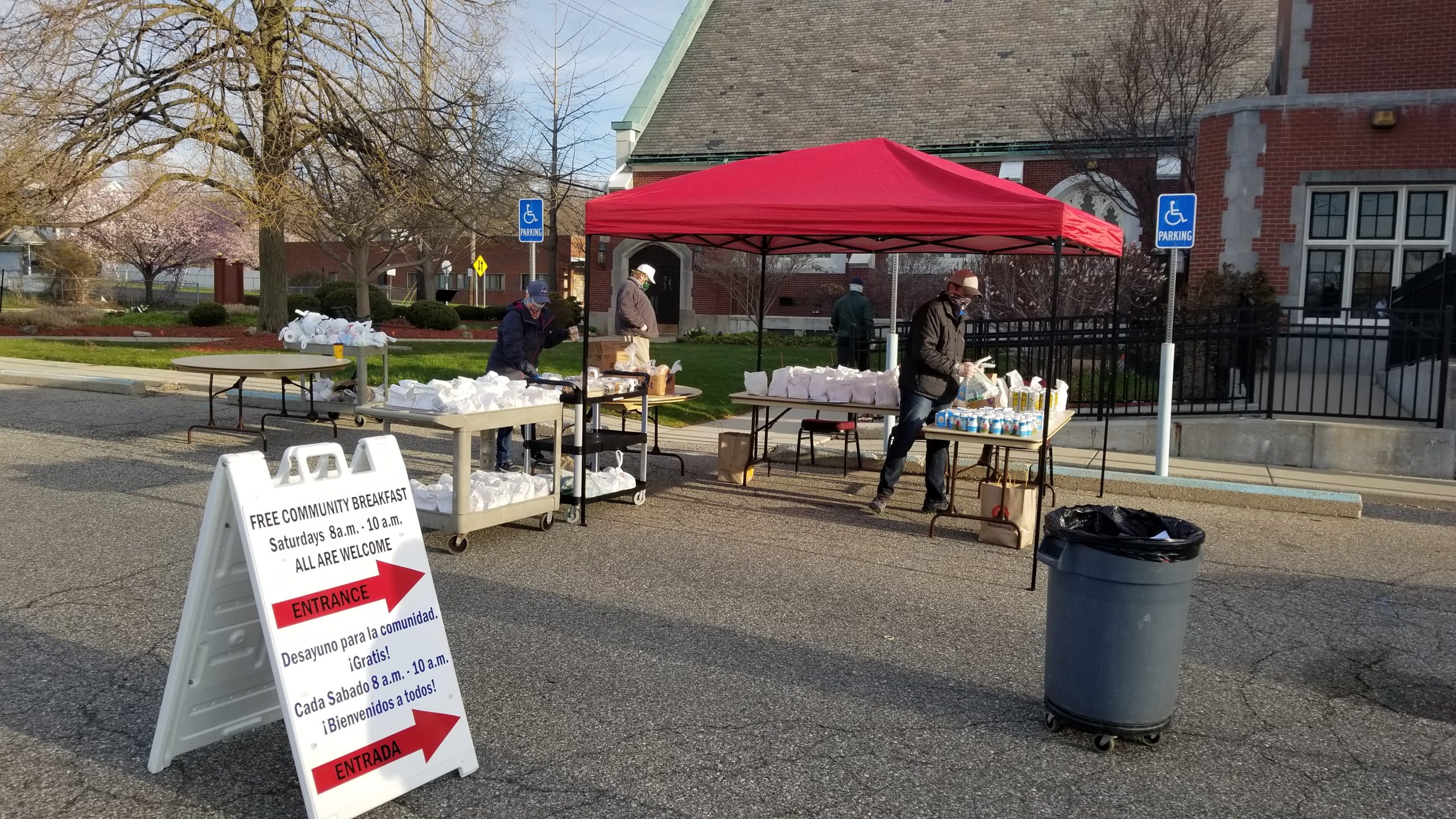
Community breakfast, moved to the church parking lot to encourage social distancing. Photo: Michael Kobylik
Responding to the Pandemic
“The church is not a building, the church is not a steeple,” says the children’s song often sung in Sunday School. While this is helpful for illustrating a core tenant of Christian theology, the COVID-19 crisis has revealed that a congregation’s relationship with its physical space is more profound than the lyrics suggest. Sacred spaces are essential service sites, providing space for homelessness relief, feeding programs, recovery meetings, child care and education, and a myriad of other services; the need for this space does not disappear during a pandemic. Therefore, many congregations are finding ways for their property to continue to serve as vehicles for ministries and services.
All Saints’ knew that it could no longer provide a sit-down meal experience for its breakfast program; there was no way to maintain social distancing measures in its auditorium where the breakfast had traditionally been served. “Our building’s not the only option,” Rev. Johnson notes. “We have a huge parking lot [as well].” The parking lot provided a large, open-air venue to distribute packaged breakfasts with appropriate precautions—volunteers handed out clamshell containers to individuals lined up with six feet of space between them. This also provided a model to distribute meals to students who could no longer attend school; Bound Together, a youth services program housed in the church’s building, replicated the new community breakfast procedures and became an official student meal distributor for the city. All Saints’ is currently exploring ways to adapt its farmer’s market to supplement the feeding programs so that households in economic distress do not go hungry.
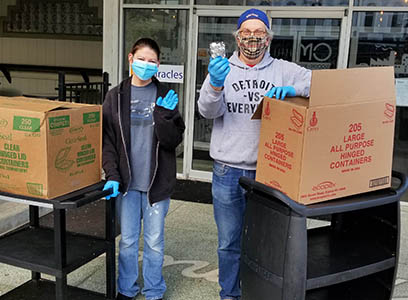
Picking up warm food from Little Mo’s, local restaurant and project partner. Photo: Michael Kobylik
Although they can no longer host social gatherings, houses of worship are still critical to the social safety net and can play an important role in strengthening coordinated local response and relief efforts. Many faith communities with existing feeding ministries have been able to maintain their outreach by becoming distribution centers. Municipal hunger-relief programs are relying on these congregations to strengthen their networks of feeding sites. Many congregations are partnering with local healthcare providers to strengthen the system and prevent hospitals from becoming overwhelmed; sacred spaces are serving as testing sites as well as temporary treatment centers for non-COVID patients. In an online conversation about how faith communities could support statewide efforts, Michigan Lt. Governor Garlin Gilchrist encouraged congregations to work in tandem with their local governments to build a comprehensive network of services and to meet community needs.
Conversations and relationships are key to this approach. Congregations must be able to identify how their buildings—and the services they have supported—can be best leveraged in the larger network of services across the community. “We need to know the real, articulated need so that our response is to a need and not just something that makes us feel good,” said Rev. Johnson. “We know there’s a need for food, we understand that broadly. So then how do you provide that in a way that’s meaningful?” While service partnerships will vary by city and neighborhood, depending on the extent of need, they all have the potential to extend beyond the current pandemic. The first step a congregation can take: reaching out to the local agencies that are coordinating the local relief effort, as well as any local body overseeing emergency management. These entities will have the most comprehensive picture of the relief effort that is needed and will be able to help a congregation identify how to best leverage its own resources to meet the needs of the surrounding community. When a congregation reaches out—and communicates to the community that it is alive and well—new opportunities to use and sustain its buildings are likely to emerge. Trinity Episcopal Church in Covington, Kentucky, for example, has erected several large banners which boldly say “WE ARE STILL HERE.”
Socially-Distanced Building Care
A congregation’s physical campus, which often has several spaces large enough to accommodate social distancing measures, continues to be an important asset for congregations to utilize and share for the health and wellbeing of their communities. On the other hand, a building that appears to be dark and closed can send a variety of signals out to the community, many of them negative. Attention to the physical building and its presence in the community remains an important responsibility for congregations, especially in times of crisis.
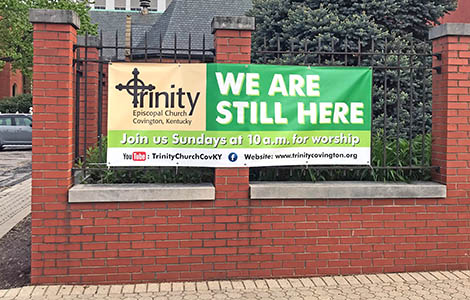
Banner at Trinity Episcopal Church, Covington, Kentucky with bold declaration. Photo: The Rev. Peter D. D’Angio
Though in-person worship services may not be possible, and though staff may not work out of the building on a daily basis, the building should not be ignored and unchecked for several days on end. Having at least one person come to the building somewhat frequently will provide the opportunity to do a quick check of systems such as plumbing and heating, and detect any problems such as vandalism or new water leaks. Keeping the exterior lit and showing some activity signals to the community that the building has not been abandoned. The placement of temporary banners or signage around the building, indicating that the congregation is alive and doing new things, can also deliver a strong and life-affirming message to the community.
Many congregations have also opted to record part or all of their weekly online worship services in the sanctuary. This practice brings joy to congregation members by attempting to capture the feeling of in-person worship experience, and it also reminds and reinforces the before the building is used at the same level of intensity that existed before March of 2020. While this presents difficulties for congregational life, it also presents a unique opportunity for maintenance and repair. With the congregation and staff absent from the building for an extended period of time, it may be easier to undertake a large maintenance or repair project. Further, pursuing such a project at this time will have an outsized economic impact on local contractors and related businesses. This kind of initiative can breathe life into the building and demonstrate to the community that the congregation is investing in its physical structure and its neighborhood.
Responsible building stewardship requires money, even during this time has, especially during a crisis, helps congregation members understand the urgency of the situation and the need to continue to give. Celebrating the generosity of congregation members, and the personal impact that their dollars will have, can motivate donors to learn and utilize new ways of gift-making (e.g. automatic bank draft, use of apps like Venmo and Paypal) instead of waiting until they can put a physical check in the offering plate again. Clergy are finding that being open and honest about the congregation’s financial situation, and asking directly for financial support, is yielding positive responses.
Reflecting and Recalibrating
Although one of the lessons of the COVID-19 crisis has been that faith communities are not solely dependent on their buildings to serve congregation members and their neighbors, it has also highlighted the immense value that the sacred place brings to ministry and service. “For so many people, churches are the only place they know to go for help,” says Rev. Courtney Stange-Treger, Minister for Church Vitality for the Pacific Northwest Conference of the United Church of Christ. Rev. Stange-Treger has seen a marked change in a region that is known for low church involvement. “Local communities are learning how vital [sacred places] are.”
As cities and states begin phased reentry and prepare for subsequent waves of the virus, congregations should continue to offer their buildings and other assets, tangible and intangible, to the broad relief effort. It is hard to predict exactly how any particular congregation might be called upon, but it is imperative for every faith community to engage with community stakeholders and agencies coordinating relief and response. Disasters, in their own way, provide unique opportunities to form relationships that can strengthen local service networks in preparation for future crises. All Saints’ Episcopal Church now knows much more about the array of feeding programs in Pontiac, and where to send people for lunch and dinner after they drop by the parking lot for breakfast. The congregation’s commitment to feeding families in need through the crisis has also led to new partnerships that will strengthen its breakfast program over the long run. Already, a local fast food restaurant has committed to donating breakfast sandwiches, and All Saints’ is working with other restaurants to expand its capacity to serve. “I think that communities in general are going to find themselves drawing closer together and more collaborative as a result of this,” said Rev. Johnson. He and other leaders are looking forward to how All Saints’ can serve as a more prominent and connected entity in Pontiac over the coming months and years of economic and social recovery. Many people, of faith or not, are realizing the critical role of sacred places in the invisible safety net of community services. The pandemic experience has the potential to shift narratives about the relationship of congregations to their communities, and the role that sacred places play. This awareness should lead to new conversations, both within congregations and with community stakeholders, about how congregations can best leverage their assets in times of crisis and beyond.
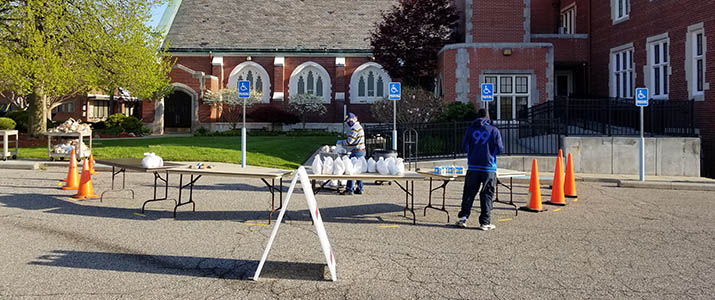
Community breakfast being set up to encourage physical distance between volunteers and people being served. Photo: Michael Kobylik

